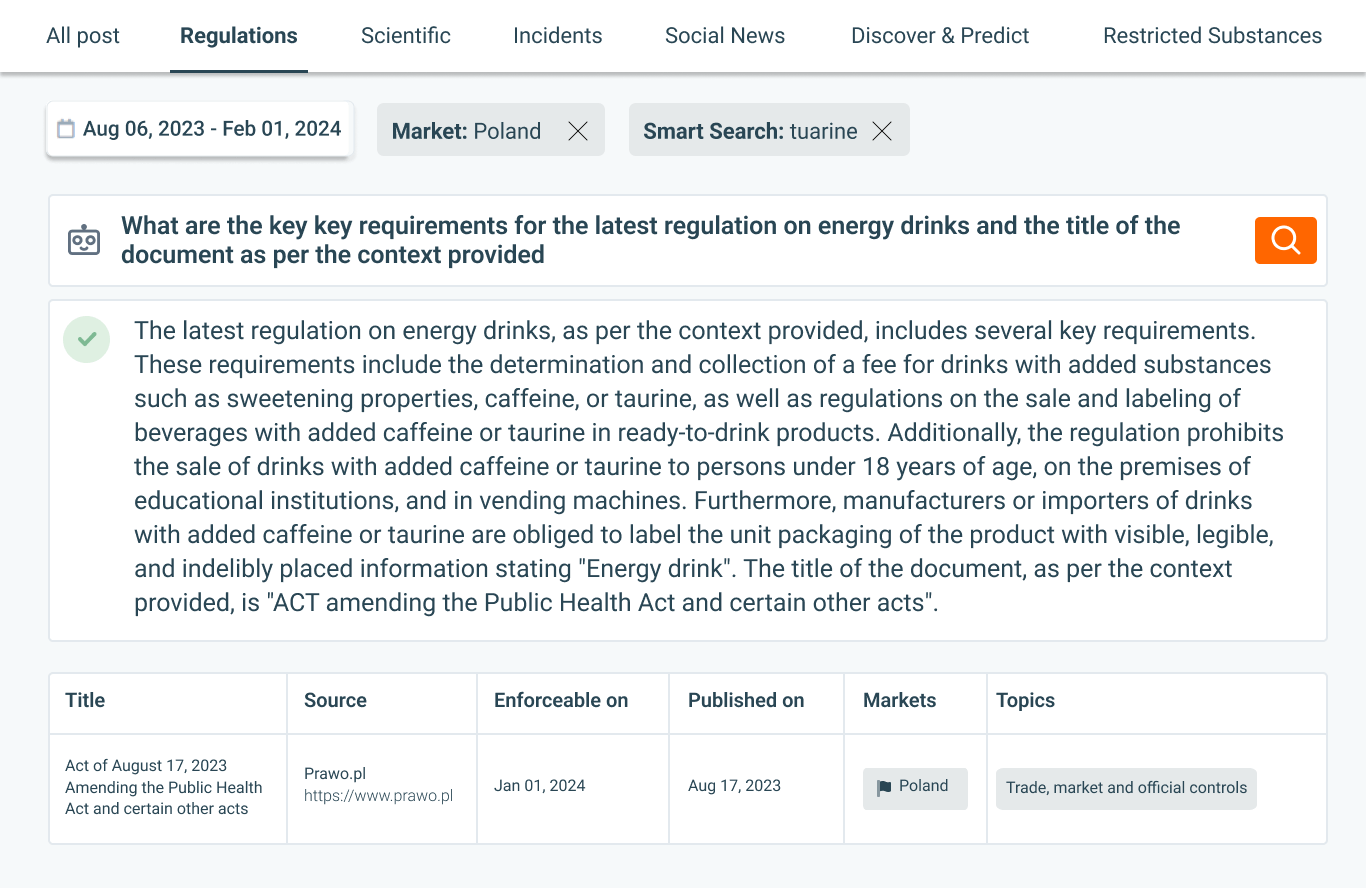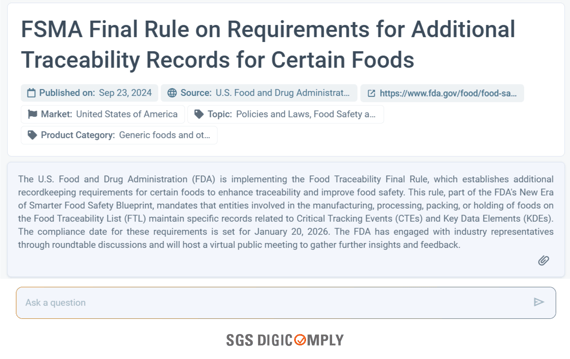Remember when everyone said January 2026 was the hard deadline for FSMA 204 compliance? The FDA has adjusted the timeline in response to industry feedback.
On March 20, 2025, the FDA announced a 30-month extension, pushing the compliance date to July 20, 2028. That's an extra two and a half years. Industry associations like FMI and the National Grocers Association applauded the decision. Consumer advocacy groups called it a betrayal. And somewhere in between, thousands of food safety professionals are asking themselves: "Should I hit pause or step on the gas?"
The critical question for the industry: treating this extension as permission to slow down would be a costly mistake.
This notification was timely identified and is available to users through the SGS Digicomply Regulatory Agenda. It offers a comprehensive list of regulatory deadlines, including historical and upcoming dates, with detailed insights and analysis. Explore the demo to try this tool in action.
The Real Story Behind the Extension
The extension reflects a pragmatic response to industry realities.
The FDA's reasoning was straightforward: even companies positioned to meet the January 2026 deadline expressed concerns about supply chain coordination. The rule requires information sharing across multiple entities, and when your compliance depends on receiving accurate data from partners who aren't ready, you have a problem.
A deeper look at industry readiness reveals additional challenges: awareness of the rule remains alarmingly low, particularly among small and medium-sized suppliers, foreign suppliers, non-chain restaurants, and companies without strong industry association ties. Beyond technology gaps, there are fundamental misunderstandings of what compliance actually requires.
Some companies genuinely believe their current operations already meet the requirements. They don't. And they won't realize it until they're in an audit or, worse, in the middle of a recall.
Why the Original Deadline Failed (And What That Tells Us)
Industry reports reveal a common pattern: QA managers at mid-sized processors often assume they're "mostly compliant" because they have lot codes. The reality check comes when they discover they can't provide FDA with an electronic sortable spreadsheet within 24 hours, or when they realize their warehouse management system can't capture all the Key Data Elements without a complete overhaul.
Warehouse management systems pose particular challenges because not all are capable of capturing KDE data points without major overhauls that could take years to complete. Distributors handling thousands of different FTL items face exponential complexity, especially when pallets contain mixed lots or products.
Here's a real scenario: You're a distributor with 5,000 SKUs. About 30% are on the Food Traceability List. During receiving, you're handling mixed pallets from multiple suppliers. The rule requires recipients to share Traceability Lot Codes (TLCs) and TLC source information with FDA, which stakeholders interpreted to mean every case must be labeled and scanned—significantly increasing labor, equipment, and space costs.
This isn't about installing software. It's about fundamentally restructuring how you handle product flow.
The Hidden Compliance Trap: Your Suppliers
According to McKinsey, 70% of large-scale transformations fail. FSMA 204 compliance is particularly vulnerable because your success depends on suppliers changing how they do business with you.
Think about that for a moment. You can have the most sophisticated traceability system in the world, but if your tomato supplier can't provide proper harvest location data and traceability lot codes, you're non-compliant.
Supplier onboarding has proven to be one of the biggest hurdles for enterprise organizations. And here's the uncomfortable truth: many of your suppliers are also supplying your competitors, who are asking them for the exact same traceability data. The supplier fatigue is real.
Industry experience demonstrates the complexity: companies that began supplier outreach in early 2024 report they're still working through their networks as of mid-2025. The process takes months, not weeks. You need to:
- Identify which suppliers provide FTL foods
- Assess their current traceability capabilities
- Communicate new requirements
- Validate they're capturing the right data
- Test data exchange formats
- Address gaps and non-compliance
If you have hundreds or thousands of suppliers, this isn't a project—it's a multi-year program.
What the Extension Changes (And What It Doesn't)
Let's be tactical. Here's what actually changed:
Changed:
- Compliance deadline: July 20, 2028 (vs. January 20, 2026)
- Time for technology implementation
- FDA's approach to industry collaboration
Didn't Change:
- The requirements themselves
- The Food Traceability List
- Critical Tracking Events and Key Data Elements
- The 24-hour response requirement
- The need for electronic sortable spreadsheets
The core requirements remain unchanged, and market-driven demands are creating higher standards than FDA mandates. Some retailers already require traceability data within two hours—not 24—which means upstream suppliers must be technologically ready well ahead of regulatory deadlines.
This is where the conversation gets interesting. While FDA gave you until 2028, your customers might not.
The Competitive Angle No One's Talking About
Here's a question: What happens to companies that achieve compliance early?
They become preferred suppliers. They win contracts. They charge premiums.
A survey found that 71% of consumers feel traceability is important and would pay a premium for traceable products. But it's not just consumers—buyers are using traceability as a procurement filter.
Industry procurement trends show that companies are adding "FSMA 204 ready" as a qualification criterion in RFPs dated for mid-2026. They're not waiting for 2028. They're using the regulation as a sorting mechanism to identify sophisticated suppliers versus those just trying to get by.
The companies treating this as a compliance checkbox are missing the strategic opportunity. The companies treating this as a competitive differentiator are gaining market share.
The Path Forward: Five Non-Obvious Insights
1. Don't Wait for Perfection
Industry trends show companies delaying implementation in pursuit of the "perfect" system, while their competitors go live with "good enough" systems that they iterate on. The compliance period has elevated conversations and inspired action. There's no turning back.
Start capturing data now, even if your system isn't perfect. You'll learn more from three months of actual usage than from six months of planning.
2. Your Technology Decision Matters Less Than You Think
For many retailers and distributors, existing EDI capabilities are an under-utilized yet powerful approach. Since information is already passing between trading partners, all that's needed is ensuring this data includes the required KDEs.
You might not need that expensive traceability platform. You might just need to enhance what you already have. The key is having someone who understands both your current systems and FSMA requirements.
3. The Exemptions Are More Complex Than They Appear
Industry audits reveal multiple cases where companies claimed exemptions they didn't qualify for. The FDA's exemption decision tree looks simple until you actually walk through your operations.
Food service distributors, for instance, often think they're exempt as "retail food establishments" until they realize that designation has specific criteria around direct-to-consumer sales that they don't meet.
Get a legal opinion. Don't self-diagnose.
4. Mock Recalls Are Your Best Diagnostic Tool
Want to know if you're actually ready? Run a mock recall for an FTL product.
Can you produce all required KDEs within 24 hours? Can you generate an electronic sortable spreadsheet? Can you trace one step back and one step forward?
The companies doing quarterly mock recalls are finding gaps they never would have identified through documentation review alone.
5. Cultural Change Beats Technical Change
The hardest part isn't the software. It's getting receiving clerks to scan every case. It's getting supervisors to verify data entry. It's getting managers to treat traceability data as critical as financial data.
Case studies show successful approaches: facilities posting "Days Since Last Traceability Data Error" signs on production floors, or tying bonus metrics to traceability data accuracy. These cultural interventions have proven more effective than technology upgrades alone.
The 2028 Timeline: How to Use It Wisely
If you're starting today, here's a realistic timeline:
2025 Q4:
- Gap analysis and supplier mapping
- Leadership buy-in and budget allocation
2026 Q1-Q2:
- Technology selection and supplier outreach
- Traceability plan development
2026 Q3-Q4:
- System implementation and supplier onboarding (this takes longer than you think)
2027 Q1-Q2:
- Data collection and validation
- Mock recalls and refinement
2027 Q3-Q4:
- Full-scale testing
- FDA-ready documentation
2028 Q1-Q2:
- Final validation
- Buffer for unexpected issues
Notice that's a 30-month plan. If you're reading this in late 2025 and thinking "I've got time," you have exactly enough time if you start immediately.
The Bottom Line
As Angela Fernandez from GS1 US aptly noted, this extension gives organizations an opportunity—but it's a mistake to de-prioritize or sit back and wait. Changes in people, processes, and technology take time regardless of where you fall in the supply chain.
The FDA gave the industry more time because many weren't ready. That doesn't mean you should join the unprepared cohort.
The question isn't whether you'll comply—the question is whether you'll comply strategically or desperately. Will you use the next 30 months to build a competitive advantage, or will you scramble in 2027 when you realize you're behind?
The extension is a wake-up call dressed as a reprieve. The smart money is on companies that recognize the difference.
Key Resources:
Explore SGS Digicomply’s Regulatory Intelligence Hub
SGS Digicomply’s Regulatory Intelligence Hub offers a powerful solution for managing regulatory complexities across 150+ jurisdictions. With AI-driven research tools, easy-to-read regulatory guides, change monitoring, and an interactive agenda, the platform empowers teams to make informed, timely decisions. Whether you’re tracking new rules or comparing global standards, SGS Digicomply is your essential partner for proactive compliance. See how it works in our demo.







.webp?width=1644&height=1254&name=Food%20Safety%20Dashboard%201%20(1).webp)
